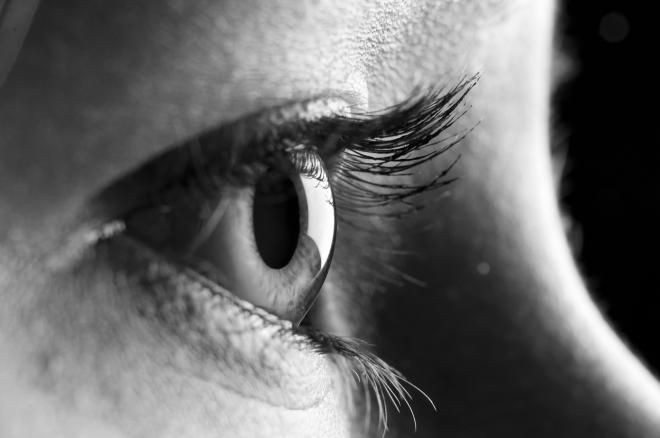Body Language Science: How Eyes Reveal Deception And Attraction

It takes seven seconds. You walk in, smile, shake hands. In those brief moments of nonverbal communication, experts say, most people form their first impression. And what we don’t express verbally, we communicate with the most powerful type of body language.
“The eyes, chico. They never lie.” Scarface fans will recognize that line from when Tony Montana tells his friend Manny that he’s sure his boss’s wife Elvira likes him.
He was right. Our eyes often reveal more about our thoughts and feelings than our words. They’re the reason we maintain eye contact in interviews to exude confidence, or why we’re told as children not to stare too long at the family dog — prolonged staring is a form of intimidation and shows dominance. Both examples are basic eye language most people are aware of and consciously control. But unconscious expressions in the eyes may offer important information.
When Someone's Lying
Conventional wisdom says people avert their eyes when lying. A 2010 report on two worldwide studies, published in the Journal of Cross Cultural Psychology, found one common belief across 75 countries and 43 different languages: Liars avert their gaze. The authors, however, disagreed, citing various studies that showed humans are sensitive to gaze direction from birth.
Early on, mother-infant interaction is based on eye contact, so when a mother breaks the mutual regard, infants come to associate it with disapproval, “and soon thereafter, they are inferring deceit from gaze aversion. Although they often disbelieve fishy-looking truth tellers, perceivers rarely learn from their mistakes,” the authors wrote. In fact, they added, experiments have shown Westerners only accurately detect lying 54 percent of the time, so gaze aversion may not be a reliable detection method.
Blake Eastman, body language expert and founder of The Nonverbal Group, agrees you can’t use breaking eye contact as a baseline for making an assumption.
"It could be that they looked away because they’re uncomfortable with what’s happening," he said. "It could be embarrassment, it could be shame, [maybe] the person suffers from high social anxiety. There isn’t any concrete study that shows breaking eye contact indicates lying."
Instead, research shows adults make eye contact an average 30 to 60 percent of the time during conversation, according to communications-analytics company Quantified Impressions, The Wall Street Journal reported. In one-on-one conversations, for example, it’s standard to hold eye contact for seven to 10 seconds, Ben Decker, chief executive officer of Decker Communications, a San Francisco-based training and consulting firm, told WSJ. So if a person breaks eye contact, it doesn’t necessarily mean he’s untrustworthy.
In fact, maintaining an unusually strong amount of eye contact may be a red flag. In the true nature of a liar, he will look for ways to deceive, and that includes being hyper-aware of not breaking eye contact, according to Eastman, since it’s commonly considered a “giveaway.”
Another indication of lying may be decreased blink rate resulting from cognitive overload, which is the theory that when a person becomes overwhelmed with thinking (or creating a lie), his blink rate dramatically decreases. However, like gaze aversion or unusually strong eye contact, decreased blink rate, too, varies for each individual.
“You’re looking for shifts in someone’s behavior,” Eastman said, explaining there are different drugs, for example, that may even affect blink rate. “If I told you right now, I want you to walk into that room and make up a story that’s completely untrue, that’s going to create a lot of cognitive overload. But when people lie they don’t create stuff out of thin air,” Eastman said. Instead, they use memories, what they know, so it’s not completely fabricated, and that in turn may not cause as much cognitive overload and decreased blink rate.
“It is almost impossible, to say if a person does X, it means they’re lying. … It’s never that simple. … Lie detection is the single most hardest thing to apply.”
When Someone's Attracted To You
Dating experts will tell you maintaining strong eye contact shows interest. We’d look away if we didn’t want to learn about the person, right? Genuine interest causes us to fix our eyes on the subject; we become excited, and in the process, our pupils dilate.
According to Eastman, there is a strong correlation between arousal and specific eye movements like dilation and blink rate. Our eyes naturally dilate to allow more light in, but dilation also occurs in response to cognitive and emotional events. So when we’re interested or in any way emotionally stimulated — positively or negatively — by what we’re looking at, our pupils dilate.
Men tend to be attracted to women with larger pupils. So much so that in Italy, over five centuries ago, women used Belladonna plant extract to dilate their pupils in an effort to appear more attractive, Scientific American reported.
Increased blink rate, in some cases, is another strong indication we’re lusting after a person. For some people, blink rate spikes when they’re emotionally excited, Eastman explains, so consistent blinking (more than the average 10 blinks per minute) may be another sign a person’s attracted to you.
As informative as pupil dilation, blink rate, gaze aversion, and unusually prolonged eye contact can be, though, Eastman says the muscles around the eyes communicate the strongest message. Without them, squinting wouldn’t convey confusion. Raising eyebrows wouldn’t demonstrate shock. Lingerie models wouldn’t achieve a seductive look. And that person you're hoping to connect with wouldn't light up when you walk in the room.
© Copyright IBTimes 2024. All rights reserved.





















